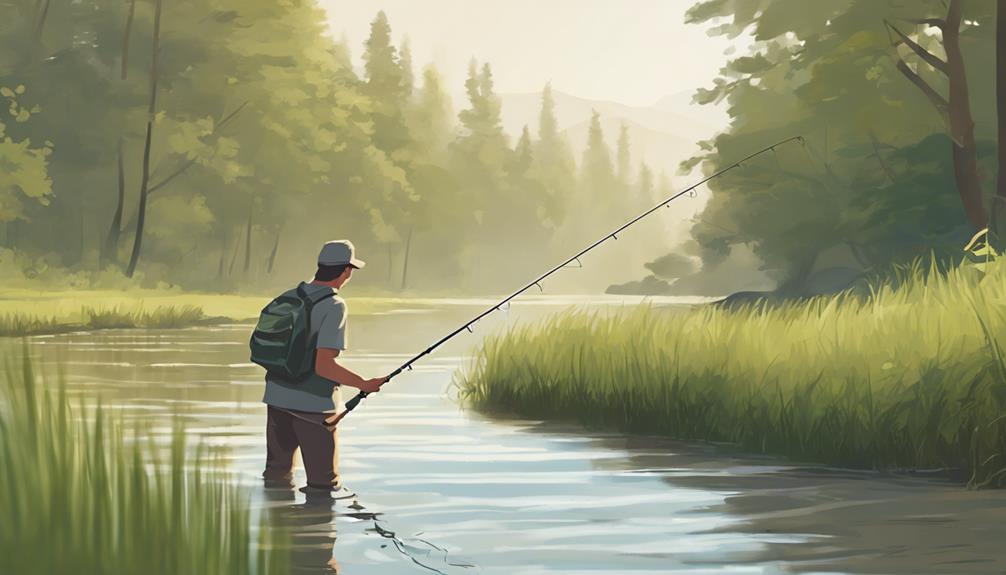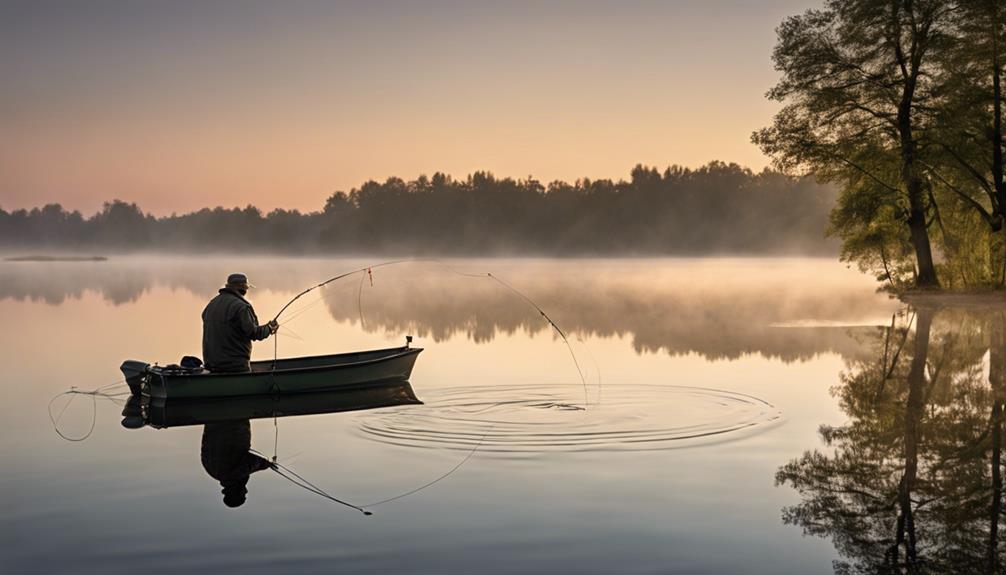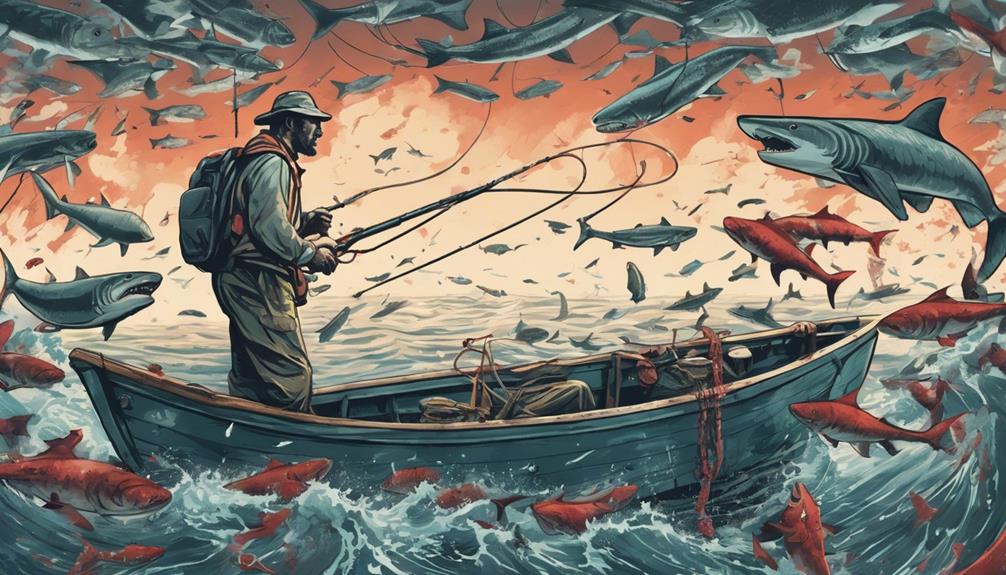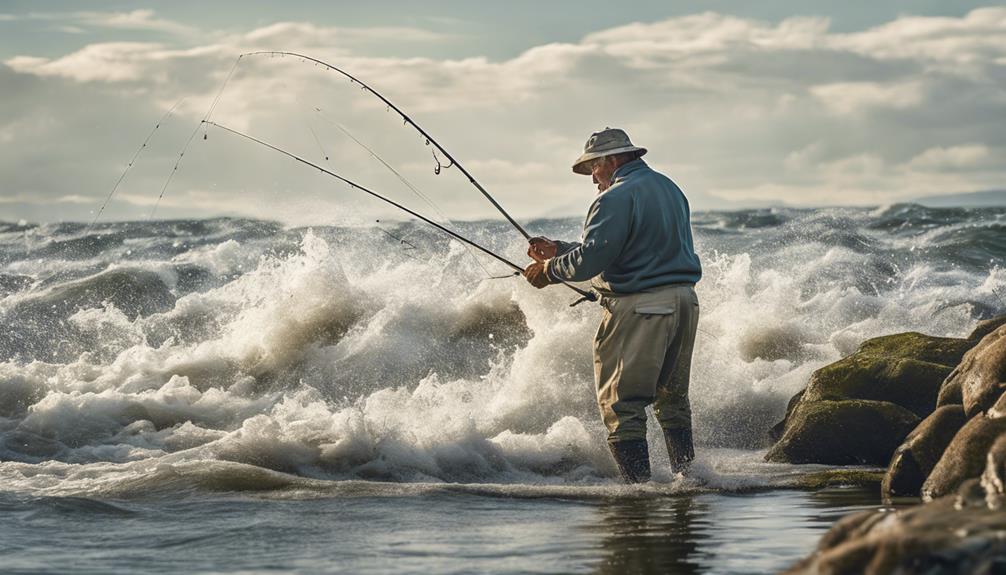Imagine river bank fishing as a delicate dance between you and the elusive fish, where every move counts towards a successful catch.
But how do you ensure you're performing the right steps to entice the fish to take the bait? By honing in on key techniques that can make all the difference between a day of frustration and one of bountiful catches.
From choosing the perfect spot to understanding the intricacies of river currents, each element plays a crucial role in your fishing success.
Selecting the Right Spot
To maximize your chances of a successful fishing trip, pinpoint a location where the river bends or where there are visible underwater structures. Reading water is crucial in determining where the fish are likely to be. Look for areas where the current changes speed or direction, as these are often hotspots for fish gathering. Fish tend to seek shelter from strong currents, so locating calmer pockets behind rocks or logs can lead to a successful catch.
When selecting a spot, pay close attention to locating structure. Fish are drawn to underwater structures such as fallen trees, boulders, or submerged vegetation. These structures provide fish with protection from predators and a place to hide while they wait for prey. By fishing near these structures, you increase your chances of attracting fish.
Additionally, consider the depth of the water. Deeper sections of the river are often home to larger fish, while shallower areas may have more smaller fish swimming around. By understanding the depth of the water in different spots along the riverbank, you can target the specific type of fish you're looking to catch.
Using the Proper Equipment
For successful river bank fishing, ensure you have the right equipment tailored to the specific needs of the location and target fish. Proper tackle and rod selection are crucial. Choose a fishing rod that suits the type of fish you're targeting and the casting distance required. Lighter rods work well for smaller fish, while heavier rods are necessary for larger species. When it comes to tackle, have a variety of hooks, sinkers, and baits to adapt to changing conditions.
Equipment maintenance is key in ensuring your gear functions optimally. Regularly clean your rods and reels to prevent corrosion, especially if fishing in saltwater. Check your lines for any signs of wear and replace them when needed to avoid losing a catch due to a breakage. Organize your gear efficiently by using tackle boxes or bags to keep everything accessible and in good condition.
Investing in quality equipment will enhance your fishing experience. While it may be tempting to cut costs, reliable gear can make a significant difference in your success rate. Before heading out, double-check that you have all the necessary equipment, including extra line, hooks, and tools for any unexpected situations. By being prepared and maintaining your gear, you'll be well-equipped for a successful day of river bank fishing.
Understanding River Currents
Navigating river currents is essential for successful fishing, as they play a significant role in fish behavior and feeding patterns. Understanding river currents involves being aware of safety precautions and grasping water dynamics to enhance your fishing experience.
Safety precautions are crucial when fishing in rivers with strong currents. Always wear a life jacket, especially if you're wading into the water. Be mindful of slippery rocks and swift currents that can easily sweep you off your feet. It's also essential to inform someone of your fishing location and expected return time for added safety.
Water dynamics play a vital role in determining where fish are likely to be found. Fish are often drawn to areas with slower currents where they can conserve energy and wait for food to come to them. Understanding how currents move around bends, eddies, and obstacles can help you predict where fish might be lurking. By positioning yourself strategically in relation to these dynamics, you can increase your chances of a successful catch.
Employing Different Baits
Understanding river currents is crucial for successful fishing, and one way to increase your chances of a catch is by employing different baits. When it comes to bait presentation, consider the type of fish you're targeting. Some fish are attracted to live bait like worms or minnows, while others may prefer artificial lures such as spoons or crankbaits. Experimenting with various baits can help you determine what works best in different conditions.
Lure selection is another essential aspect of successful river bank fishing. Different lures mimic different prey, so choosing the right one can significantly impact your catch. Pay attention to the water depth when selecting a lure. Deeper waters may require diving lures, while shallow areas could benefit from surface lures. Matching the size and color of the lure to the natural prey in the area can also increase your chances of enticing a bite.
In addition to bait presentation and lure selection, casting accuracy plays a vital role in river bank fishing. Practice casting to specific spots along the river bank, such as near fallen logs or under overhanging branches, where fish are likely to hide. Being able to place your bait or lure precisely where the fish are can make a significant difference in your success. Remember to adjust your casting technique based on the current speed and direction to ensure your bait moves naturally in the water, increasing its appeal to nearby fish.
Practicing Patience and Stealth
To improve your chances of a successful catch, practice patience and move stealthily along the river bank. Fishing often involves a waiting game, where your ability to remain calm and observant can make all the difference. Employ stealth tactics to avoid scaring away potential catches. Be mindful of your movements, keeping noise to a minimum and moving slowly to not disturb the water. By blending into your surroundings and minimizing disruptions, you increase the likelihood of fish coming closer to investigate your bait.
Develop your observation skills to understand the behavior of fish in different conditions. Take note of where fish tend to gather along the river bank, observing their movements and feeding patterns. This information will help you strategically position yourself for a successful catch. Find spots where fish are likely to swim by looking for signs such as ripples on the water's surface or underwater structures that provide shelter.
Strategic positioning is key to a successful fishing expedition. By combining patience with stealth tactics and observation skills, you can increase your chances of hooking a fish. Remember that fishing isn't just about luck; it's about understanding the environment and adapting your approach to maximize your success.
Mastering Casting Techniques
For better accuracy in casting your line, focus on mastering your casting techniques. Precision casting requires timing accuracy. To achieve this, practice your casting motion to develop a smooth and controlled release. Pay attention to the placement of your lure or bait, aiming for specific spots where fish are likely to be. Timing your cast to coincide with the movements of the fish can significantly increase your chances of a successful catch.
In addition to precision casting, mastering distance casting involves power control. Work on your casting strength to accurately place your bait or lure at different distances. Practice casting at various lengths to become proficient in adjusting the power behind your cast. Remember, the goal isn't just to cast far but to cast with purpose and control.
To improve your casting techniques, consider the weight of your bait or lure and adjust your casting style accordingly. Lighter lures may require a gentler cast, while heavier baits may need more force behind them. Experiment with different casting techniques, such as overhead casting, side casting, or roll casting, to determine which works best for you in different situations.
Adapting to Changing Conditions
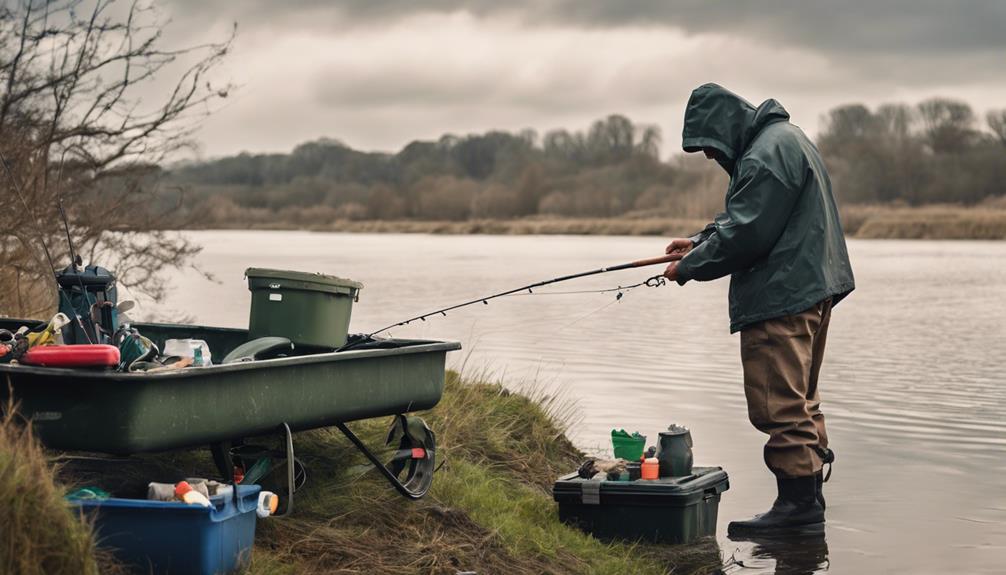
As you face varying river conditions, your adaptability in adjusting your fishing approach becomes key to maximizing your success along the banks. Weather strategies play a significant role in your river bank fishing endeavors. When the weather changes, such as a shift in wind direction or an incoming storm, be prepared to adapt your techniques. For example, if it starts raining, consider using topwater lures to mimic the sound of baitfish hitting the surface.
Water levels also greatly impact your fishing experience. As water levels fluctuate, adjusting tactics is crucial. During low water levels, fish tend to concentrate in deeper pools, so focusing your efforts in these areas can lead to more bites. Conversely, when water levels are high, fish may move closer to the banks where the current is slower. In such conditions, try using heavier baits to reach these fish.
Being flexible and willing to change your approach based on the current conditions will significantly increase your chances of success when fishing along river banks. Keep an eye on the weather forecast, observe the water levels, and be ready to adapt your techniques accordingly. By doing so, you can make the most out of your river bank fishing adventures.
Respecting Wildlife and Environment
When fishing along river banks, it's essential to show respect for the wildlife and environment by minimizing disturbances and preserving the natural habitat. To minimize your impact on the ecosystem, be mindful of where you walk and set up your fishing spot. Avoid trampling on vegetation or disturbing nesting areas of birds and other wildlife. By treading lightly and staying on designated paths or areas, you can help preserve habitats along the river banks.
When handling fish, make sure to do so with care and respect. Avoid causing unnecessary harm or stress to the fish you catch. Use proper techniques for catch and release to ensure the fish has the best chance of survival once returned to the water. This not only contributes to the sustainability of fish populations but also shows consideration for the well-being of the aquatic life in the river.
Additionally, be conscious of your waste and always clean up after yourself. Take any trash or leftover bait with you when you leave to prevent pollution and protect the environment. By leaving the river bank as you found it, you contribute to maintaining the natural beauty of the area for both wildlife and future generations of anglers. Showing respect for the wildlife and environment while fishing enhances the overall experience and helps conserve the delicate balance of the ecosystem.
Frequently Asked Questions
What Are Some Common Mistakes to Avoid While River Bank Fishing?
When river bank fishing, it's important to avoid common mistakes like:
- Casting too close to the shore
- Scaring away fish with loud noises
- Using the wrong bait for the fish in that area
Instead, focus on proper techniques such as:
- Casting further out into the water
- Being quiet and stealthy
- Using the appropriate bait based on the type of fish you're targeting
How Can Weather Conditions Affect River Bank Fishing Success?
When fishing from the river bank, weather conditions play a crucial role in your success. The right tackle selection and bait presentation are affected by factors like water clarity and current speed.
Be mindful of how the weather influences these elements. Adjust your approach accordingly to optimize your chances of a successful fishing trip.
Keep an eye on the weather forecast to plan your fishing strategy effectively.
Are There Any Specific Regulations or Restrictions to Be Aware of When Fishing on River Banks?
When fishing on river banks, it's crucial to be aware of fishing permits and any restrictions in the area. Make sure you check the regulations beforehand to avoid any issues.
Additionally, being environmentally conscious is key. Respect any conservation efforts and be aware of any rules to protect the ecosystem.
What Are Some Safety Tips to Keep in Mind While Fishing on River Banks?
When fishing on river banks, safety precautions are key. Always be mindful of your surroundings, watch for slippery rocks, and wear appropriate footwear.
Bring proper equipment like a first aid kit and a life jacket for added safety. Choose the best spots carefully and avoid areas with strong currents.
Remember to inform someone of your fishing location and expected return time for extra security. Enjoy your time on the river while staying safe!
How Can One Properly Handle and Release Fish When Practicing Catch and Release Fishing on River Banks?
When handling and releasing fish during catch and release fishing on river banks, it's crucial to use proper techniques to ensure the fish's well-being. Remember to support the fish gently, avoid touching the gills, and release it back into the water as quickly as possible.
Conclusion
Overall, effective river bank fishing requires a combination of skill, patience, and respect for the environment.
By selecting the right spot, using the proper equipment, understanding river currents, employing different baits, practicing patience and stealth, mastering casting techniques, adapting to changing conditions, and respecting wildlife and the environment, you can increase your chances of a successful fishing trip.
Remember to always stay mindful of your surroundings and enjoy the peaceful experience of fishing along the river bank. Happy fishing!
